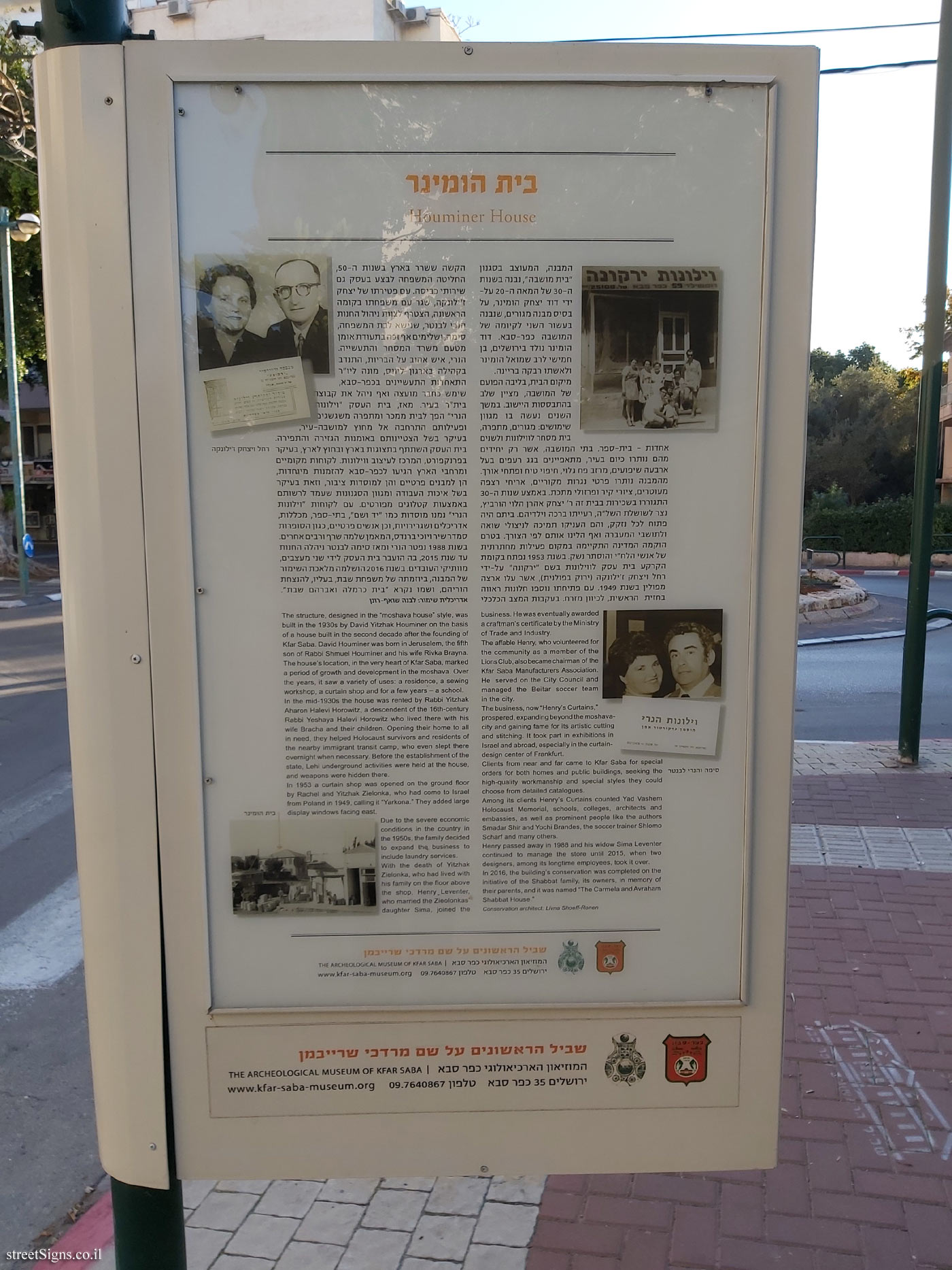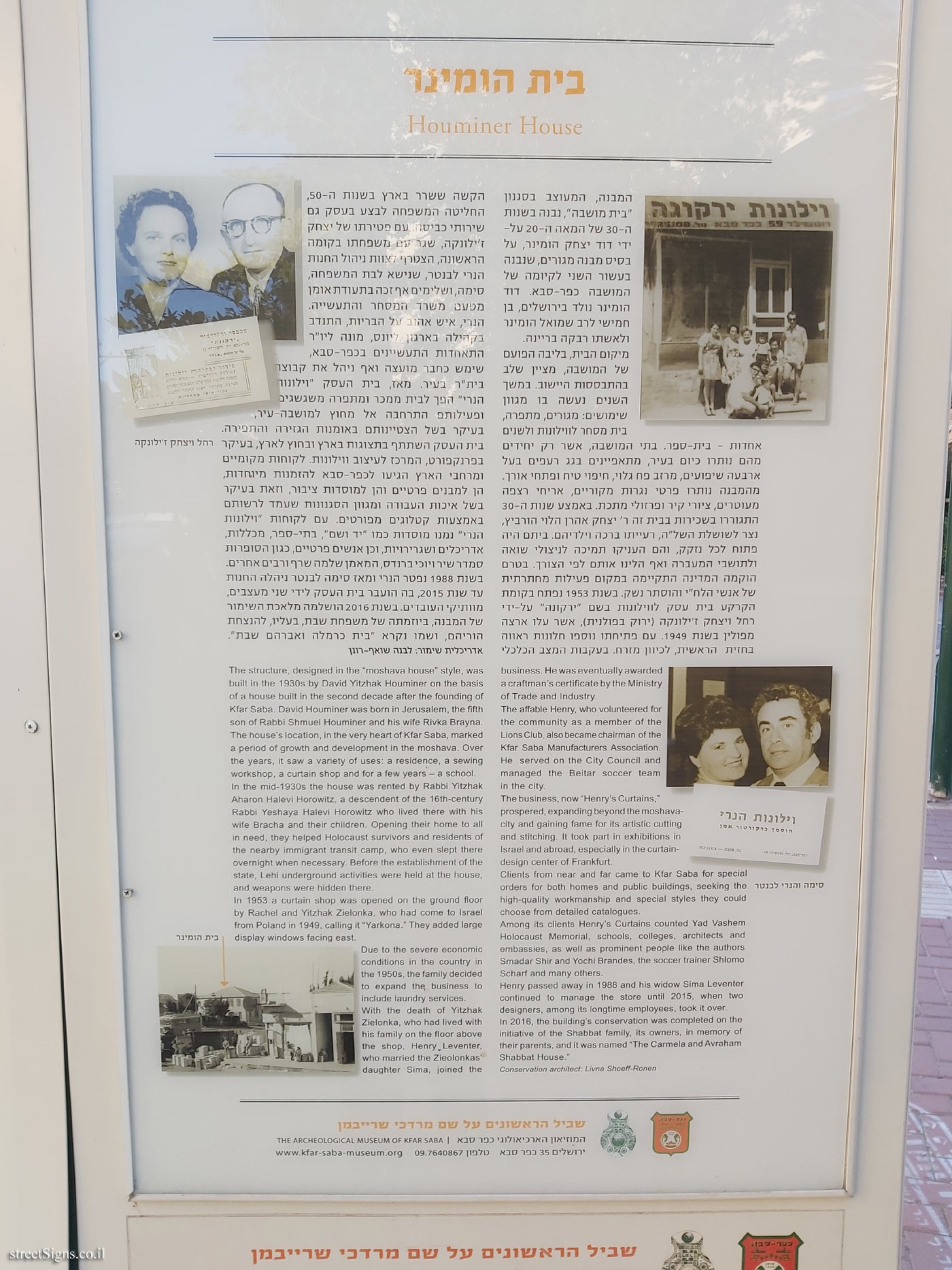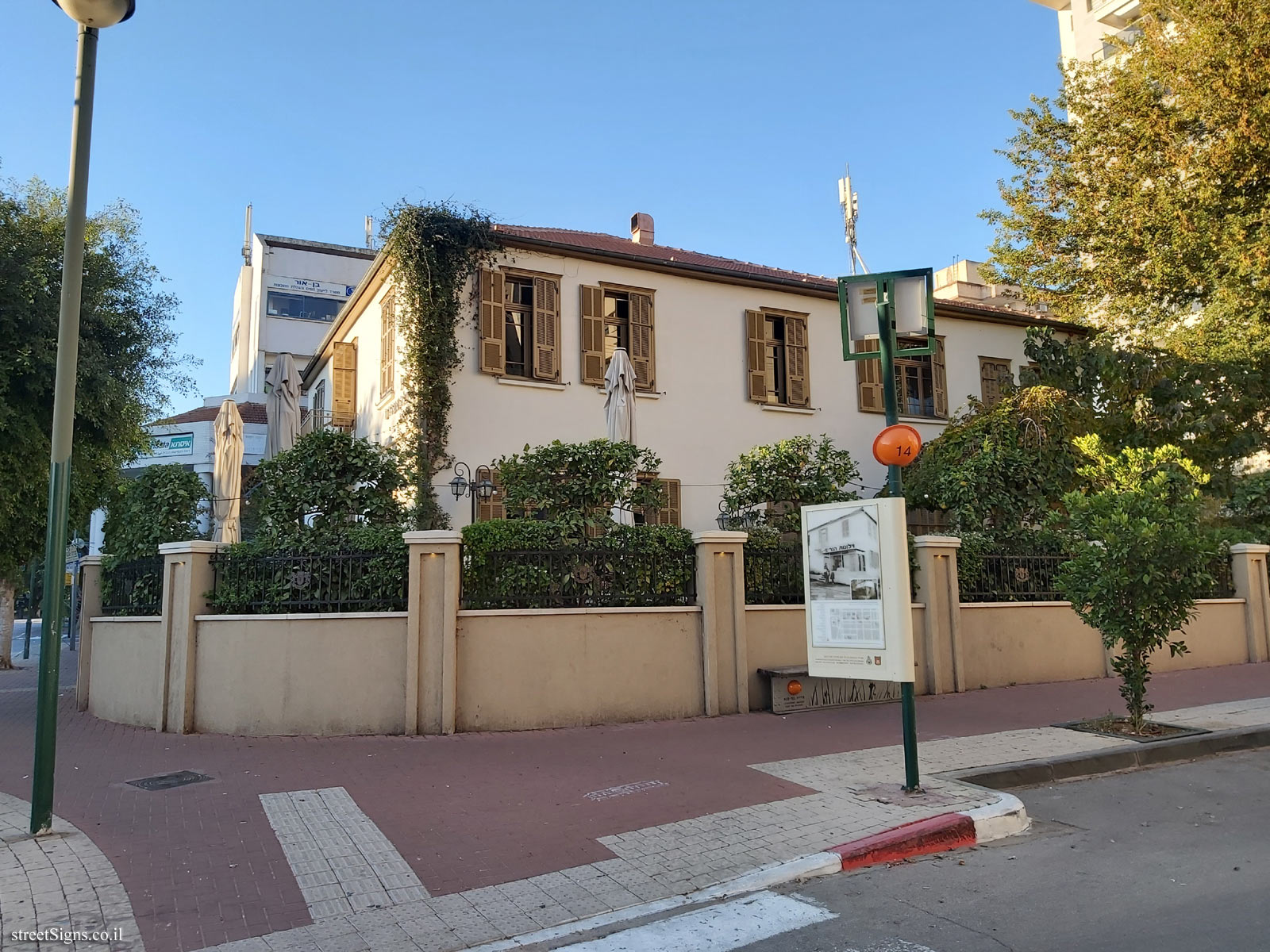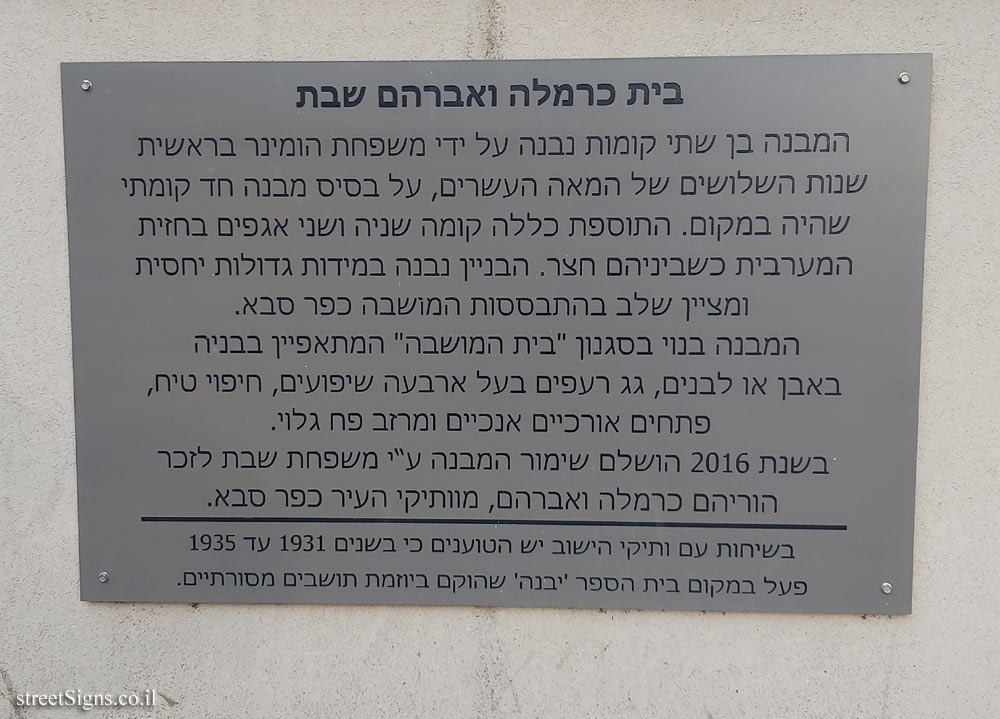On the sign:
[תמונה: בית הומינר]
[מפת השביל]
[הצד השני של השלט]
בית הומינר
Houminer House
המבנה המעוצב בסגנון "בית מושבה", נבנה בשנות ה-30 של המאה ה-20 על-ידי דוד יצחק הומינר, על בסיס מבנה מגורים, שנבנה בעשור השני לקיומה של המושבה כפר-סבא. דוד הומינר נולד בירושלים, בן חמישי לרב שמואל הומינר ולאשתו רבקה בריינה.
מיקום הבית, בליבה הפועם של המושבה, מציין שלב בהתבססות היישוב. במשך השנים נעשה בו מגוון שימושים: מגורים, מתפרה, בית מסחר לווילונות ולשנים אחדות - בית ספר. בתי המושבה, אשר רק יחידים מהם נותרו כיום בעיר, מתאפיינים בגג רעפים בעל ארבעה שיפועים, מרזב פח גלוי, חיפוי טיח ופתחי אורך. מהמבנה נותרו פרטי נגרות מקוריים, אריחי רצפה מעוטרים, ציורי קיר ופרזולי מתכת. באמצע שנות ה-30 התגוררו בשכירות בבית זה ר’ יצחק אהרן הלוי הורביץ, נצר לשושלת השל"ה, רעייתו ברכה וילדיהם. ביתם היה פתוח לכל נזקק, והם העניקו תמיכה לניצולי שואה ולתושבי המעברה ואף הלינו אותם לפי הצורך. בטרם הוקמה המדינה התקיימה במקום פעילות מחתרתית של אנשי הלח"י והוסר נשק. בשנת 1953 נפתח בקומת הקרקע בית עסק לווילונות בשם "ירקונה" על-ידי רחל ויצחק ז’ילונקה (ירוק בפולנית), אשר עלו ארצה מפולין בשנת 1949. עם פתיחתו נוספו חלונות ראווה בחזית הראשית, לכיוון מזרח. בעקבות המצב הכלכלי הקשה ששרר בארץ בשנות ה-50, החליטה המשפחה לבצע בעסק גם שירותי כביסה. עם פטירתו של יצחק ז’ילונקה, שגר עם משפחתו בקומה הראשונה, הצטרף לצוות ניהול החנות הנרי לבנטר, שנישא לבת המשפחה, סימה, ושלימים אף זכה בתעודת אומן מטעם משרד המסחר והתעשייה.
הנרי, איש אהוב על הבריות, התנדב בקהילה בארגון ליונס, מונה ליו"ר התאחדות התעשיינים בכפר-סבא, שימש כחבר מועצה ואף ניהל את בוצת בית"ר בעיר. מאז, בעית העסק "וילונות הנרי" הפך לבית ממכר ומתפרה משגשגים ופעילותם התרחבה אל מחוץ למושבה-עיר, בעיקר בשל הצטיינותם באומנות הגזירה והתפירה.
בית העסק השתתף בתצוגות בארץ ובחוץ לארץ, בעיקר בפרנקפורט, המרכז לעיצוב ווילונות. לקוחות מקומיים ומרחבי הארץ הגיעו לכפר-סבא להזמנות מיוחדות, הן למבנים פרטיים והן למוסדות ציבור, וזאת בעיקר בשל איכות העבודה ומגוון הסגנונות שעמד לרשותם באמצעות קטלוגים מפורטים. עם לקוחות "וילונות הנרי" נמנו מוסדות כמו "יד ושם" בתי-ספר, מכללות, אדריכלים ושגרירויות, וכן אנשים פרטיים, כגון הסופרות סמדר שיר ויוכי ברנדס, המאמן שלמה שרף ורבים אחרים.
בשנת 1988 נפטר הנרי ומאז סימה לבנטר ניהלה החנות עד שנת 2015, בה הועבר בית העסק לידי שני מעצבים, מוותיקי העובדים. בשנת 2016 הושלמה מלאכת השימור של המבנה, ביוזמתה של משפחת שבת, בעליו, להנצחת הוריהם, ושמו נקרא "בית כרמלה ואברהם שבת".
אדריכלית שימור: לבנה שואף-רונן
The structure, designed in the "moshava house" style, was built in the 1930s by David Yitzhak Houminer on the basis of a house built in the second decade after the founding of Kfar Saba. David Houminer was born in Jerusalem, the fifth son of Rabbi Shmuel Houminer and his wife Rivka Brayna. The house’s location, in the very heart of Kfar Saba, marked a period of growth and development in the moshava. Over the years, it saw a variety of uses: a residence, a sewing workshop, a curtain shop and for a few years - a school. In the mid-1930s the house was rented by Rabbi Yitzhak Aharon Halevi Horowitz, a descendent of the 16th-century Rabbi Yeshaya Halevi Horowitz who lived there with his wife Bracha and their children. Opening their home to all in need, they helped Holocaust survivors and residents of the nearby immigrant transit camp, who even slept there overnight when necessary. Before the establishment of the state, Lehi underground activities were held at the house, and weapons were hidden there.
In 1953 a curtain shop was opened on the ground floor by Rachel and Yitzhak Zielonka, who had come to Israel from Poland in 1949, calling it "Yarkona". They added large display windows facing east.
Due to the severe economic conditions ia the country in the 1950s, the family decided to expand the business to include laundry services.
With the death of Yitzhak Zielonka, who had lived with his family on the floor above the shop. Henry Leventer. who married the Zieolonkas daughter Sima, joined the business. He was eventually awarded a craftman’s certificate by the Ministry of Trade and Industry.
The affable Henry, who volunteered for the community as a member of the Lions Club, also became chairman of the Kfar Saba Manufacturers Association. He served on the City Council and managed the Beitar soccer team in the city.
The business, now "Henry’s Curtains", prospered, expanding beyond the moshava-city and gaining fame for its artistic cutting and stitching. It took part in exhibitions in Israel and abroad, especially in the curtain-design center of Frankfurt.
Clients from near and far came to Kfar Saba for special orders for both homes and public buildings, seeking the high-quality workmanship and special styles they could choose fron detailed catalogues.
Among its clients Henry’s Curtains counted Yad Vashem Holocaust Memorial, schools, colleges, architects and embassies, as well as prominent people like the authors Smadar Shir and Yochi Brandės, the soccer trainer Shlomo Scharf and many others.
Henry passed away in 1988 and his widow Sima Leventer continued to manage the store until 2015, when two designers, among its longtime employees, took it over.
In 2016, the building’s conservation was completed on the initiative of the Shabbat family, its owners, in memory of their parents, and it was named "The Carmela and Avraham Shabbat House."
Conservation architect: Livna Shoeff-Ronen
סמל העיר כפר סבא
סמל מוזיאון כפר סבא
שביל הראשונים על שם מרדכי שרייבמן
המוזיאון הארכיאולוגי כפר-סבא
ירושלים 35 כפר-סבא
טלפון 09.7640867
THE ARCHAEOLOGICAL MUSEUM OF KFAR-SABA
www.kfar-saba-museum.org

 Click for a larger image
Click for a larger image  Click for a larger image
Click for a larger image  Click for a larger image
Click for a larger image  Click for sign's details
Click for sign's details  Click for sign's details
Click for sign's details